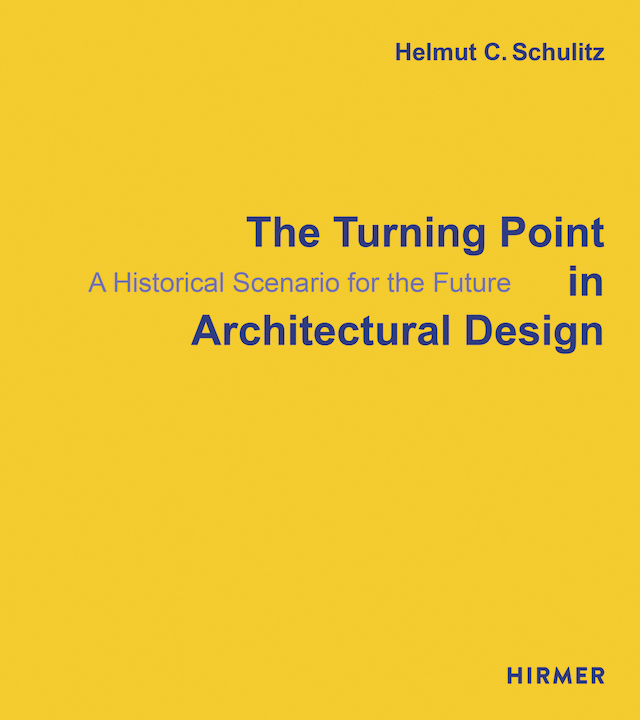The Turning Point in Architectural Design
The Turning Point in Architectural Design: A Historical Scenario for the Futureby Helmut C. SchulitzHirmer Publishers, 2021Paperback | 9-1/2 x 10-1/2 inches | 240 pages | 657 illustrations | English | ISBN: 9783777436760 | $45.00PUBLISHER'S DESCRIPTION:Over one hundred years ago, Adolf Loos had already complained: “The architect has caused architecture to sink to a graphic art.” He was pointing to a problem that had gone unnoticed for centuries. But today, in the age of digitalization, the separation between design and building practice that Loos had lamented is expanding immeasurably.Nowadays, CAD enables architects to design forms that they could neither imagine nor draw before. But where form becomes more important than function, context, and construction, architecture becomes arbitrary. Technology by itself will not bring about a turning point in building. It must be preceded by a turnabout in architectural design that can introduce further potentials of digitalization in a future-oriented way. By looking at the history of building, this richly illustrated volume opens up a scenario for the future that is needed ever more urgently in view of the global challenges we face in dealing with resources and energy.In the course of a 50-year career, Helmut C. Schulitz has both practiced and taught architecture in Europe and America and authored numerous publications.REFERRAL LINKS: dDAB COMMENTARY:In the second paragraph of chapter six, about halfway through The Turning Point in Architectural Design, Helmut C. Schulitz writes that "in today's affluent industrialized countries, the abundant options of materials are taken for granted and some architects, even those who are considered avant-garde, use materials rather wastefully, just to fulfill the desire for extravagant sculptural forms." Which architects might those be? Schulitz goes on to say that he is puzzled "when architects today appeal to Alberti's assertion that 'it is possible to project whole forms in the mind without any recourse to the material,'" citing Patrik Schumacher's The Apotheosis of Architecture in that quote. Clearly Schulitz, a practicing architect as well as an author, is not happy with the formalism of much architecture today, and The Turning Point in Architectural Design is his corrective: a means of shifting the conversation toward buildings that are efficient rather than wasteful, that are based on strong collaborations with engineers and other technical experts rather than on the whims of architects. As such, the book is full of many similar statements as that in chapter six, which express the author's beliefs on architectural innovation and take certain architects to task for not fitting into his mold. Even though most of the book's chapters look back into history, Schulitz is not averse to technology; if anything, he is a champion of architects integrating software and other technologies into their designs, but in ways that make buildings more efficient in terms of materials and energy use. His look back into history — an architect's glance, he admits, not a historian's — focuses on structure, construction, and technology, in terms of how they have been used both logically and illogically over different eras and styles. His preferences are never hard to grasp.In the current situation, Schulitz sees two camps where architects reside: "The Camp Searching for Form" and "The Camp of Preconceived Form." The former are "architects for whom architecture is still the art of building" while the latter consists of "architects who reduce architecture to the art of design." A simplification, for sure, but one that certainly holds true for the iconic projects that Schulitz focuses on in the last chapter of the book. With technology enabling both approaches — be it the "searching" in Nicholas Grimshaw's Eden Project or the "preconceived form" of Frank Gehry's Walt Disney Concert Hall — Schulitz makes a strong argument for a "resource-conscious way" of designing that is appropriate today given the environmental crises architects should be addressing.With more than 600 illustrations across its 240 pages — most of them photographs taken by the architect/author — The Turning Point in Architectural Design is a visually rich book that captures a lifetime of experiencing buildings and learning about architecture, condensing those many years and travels into an argument that is easy to grasp. Without an index, and with its mixture of history and polemic, the book is meant to be read cover to cover, in order across its chronological chapters. Even so, I dipped into here and there, and while the omission of an index makes it hard for me to use it as a reference in the future, certain chapters shine and warrant closer reading, especially the long one about industrialized housing. Ultimately, the ideal forum for Schulitz's book is clearly architecture school, in a history class or survey of modern architecture that focuses on construction, technology, eng

by Helmut C. Schulitz
Hirmer Publishers, 2021
Paperback | 9-1/2 x 10-1/2 inches | 240 pages | 657 illustrations | English | ISBN: 9783777436760 | $45.00
PUBLISHER'S DESCRIPTION:
REFERRAL LINKS:
SPREADS:








